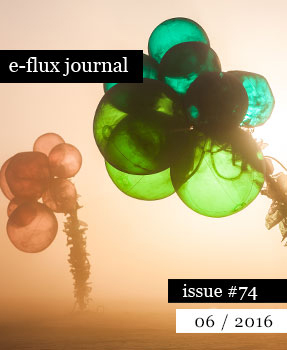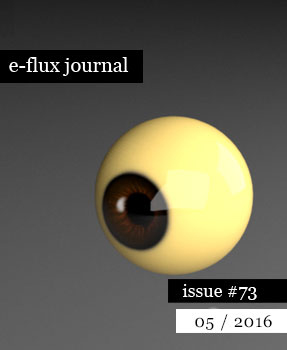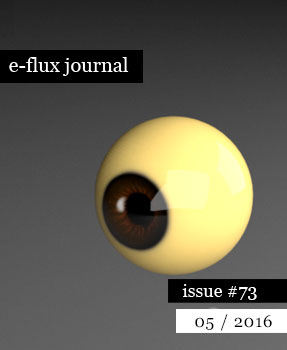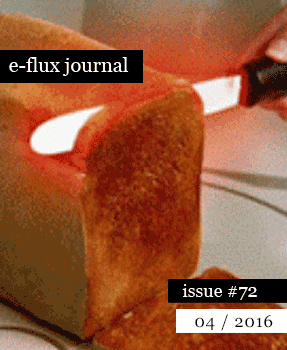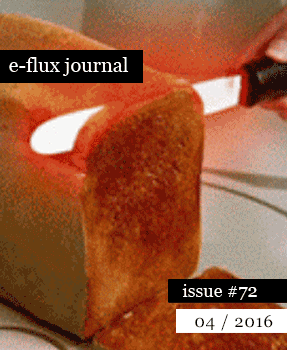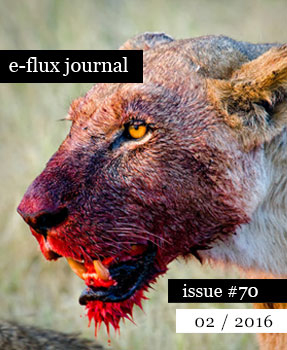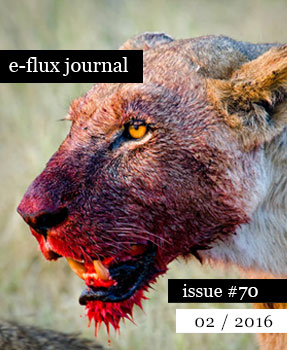e-flux journal issue 76 “The Perfect Storm”
guest-edited by Sven Lütticken
with Hito Steyerl, Ilya Budraitskis, Keti Chukhrov, Boris Buden, Ewa Majewska and Kuba Szreder, Sven Lütticken, Ana Teixeira Pinto, Tony Wood, and Jonas Staal
“How Much Fascism?” asked the curatorial collective WHW. Quite a bit, it would appear. As always, the prefix “neo-” can stand for many differences in the repetition, yet the noun asserts itself with all the subtle grace of an elephant in the room. Historical fascism, too, was a many-headed hydra, and scholarly struggles over exact definitions are ongoing, and will continue. There is no Platonic Idea, but rather a set of historically grown family resemblances—revolving around tropes such as a cult of strong male leadership that will reverse a country’s decline, the identification of the cause of that country’s decline as the work of some “other,” the need to purify and unite the Volkskörper, and an ensuing taboo regarding class conflict. Not to mention dependency on extralegal violence even while extolling Law and Order, and so on, and so on … complete, delete, bicker, and argue at will.
In January 2011, e-flux journal published a special issue entitled “Idiot Wind,” which attempted to take stock of right-wing populist movements in Europe and the US. In recent months, with Trump ascendant and Le Pen, Wilders, Pegida, UKIP, Orbán, and Erdoğan holding Europe hostage, the editors have repeatedly been complimented on the “prescience” of “Idiot Wind.” While “Idiot Wind” was more reactive than prophetic, it nonetheless identified tendencies that have continued to shape the political landscape.
Back then, the issue’s title was at times attacked as evidence of lefty-liberal arrogance, and as a failure to engage with the underlying economic and social logic of political developments; recasting Benjamin’s storm of history in a Dylanesque idiom, the title was intended as a caustic reference to the fundamental destructiveness of movements that claim to speak and act for the “populous”—defined in ethnically homogenous and often socially conservative terms—yet may harm their core voters as much as the “others” they vilify (immigrants, etc.). Now that the idiot wind has become a perfect storm, terms such as “right-wing” populism increasingly seem like euphemisms for what are varieties of neofascism.
These are marked by strong continuities as well as by disruptive innovations. One innovation may be precisely that today’s neofascisms are rarely contained within the pathological and pathetic body of various postwar fascists or neo-Nazi parties; this is viral fascism for the networked age. Clearly, the penchant for Busby Berkeley–style military spectacles is also no longer what it once was—at least in Western Europe. There are other ways of showing the Volkskörper’s strength and ability to repel alien parasites, for instance by making Muslim women take off their clothes on the beach.
How can neofascist ideologies and policies of exclusion and fortification be countered now that growing surplus populations and migration movements put pressure on old social structures? Can we take pointers from the classics—Wilhelm Reich, Benjamin, Adorno? What are the new conceptual weapons, and what are the alternative political, social, and cultural projects? And can art be anything other than part of the problem—part of an international, urban-cosmopolitan elite that has for too long been factually complicit in the extreme inequality that fuels the fascist success? Fascism may have aestheticized politics (dixit Benjamin), but what interventions are possible in the aesthetic-political economy of twenty-first century fascism?
—Sven Lütticken, Julieta Aranda, Brian Kuan Wood, Stephen Squibb, Anton Vidokle
In this issue:
Hito Steyerl—If You Don’t Have Bread, Eat Art!: Contemporary Art and Derivative Fascisms
Authoritarian right-wing regimes will not get rid of art-fair VIP lists or make art more relevant or accessible to different groups of people. In no way will they abolish elites or even art. They will only accelerate inequalities, beyond the fiscal-material to the existential-material. This transformation is not about accountability, criteria, access, or transparency. It will not prevent tax fraud, doctored markets, the Daesh antiquities trade, or systemic underpayment. It will be more of the same, just much worse: less pay for workers, less exchange, fewer perspectives, less circulation, and even less regulation, if such a thing is even possible. Inconvenient art will fly out the window—anything non-flat, non-huge, or remotely complex or challenging. Intellectual perspectives, expanded canons, nontraditional histories will be axed—anything that requires an investment of time and effort instead of conspicuous money. Public support will be swapped for Instagram metrics. Art will be fully floated on some kind of Arsedaq. More fairs, longer yachts for more violent assholes, oil paintings of booty blondes, abstract stock-chart calligraphy. Yummy organic superfoods. Accelerationist designer breeding. Personalized one-on-one performances for tax evaders. Male masters, more male masters, and repeat. Art will take its place next to big-game hunting, armed paragliding, and adventure slumming.
Ilya Budraitskis—What Can We Learn from Vampires and Idiots?
At the beginning of the nineteenth century, the figure of the vampire emerged in European culture at the same time as the birth of political conservativism. This vampire, first appearing in the pages of a well-known novel by John Polidori, was completely unlike the insurgent corpse of today’s popular superstitions. The new vampire was a Byronic beauty, an intellectual, and an aristocrat whose easy prey were the naive, enlightened representatives of high society, for whom there existed nothing beyond the limits of a rational, knowable world. The vampire carried out its attacks with impunity, existing on the frontier between the rational world of the living and the irrational world of the dead—the latter having been denied and displaced by the Enlightenment.
Keti Chukhrov—In the Nebulous Zone between Class Antagonism and Violence
Democracy has to insistently assert civil equality and constantly display concern for the disinherited and underprivileged, but at the same time it cannot help but keep such groups deprived of the conditions of genuine emancipation. This disposition tacitly affirms inequality as an insurmountable social condition even as it demonstrates social and institutional concern for the non-equal. Yet the question at stake not only concerns the vicissitudes of democracy or of “real” politics. It also concerns the possibility, in the sphere of left-leaning artistic production and cultural politics, of falling into the trap of social-democratic rhetoric. It is obvious that the leftist stance—be it in political activism, art and culture, or social struggle—is critical of representative democracy under conditions of the capitalist state. However, it is here, among the cultured, that a false democracy is implemented even as it is simultaneously criticized.
Boris Buden—With the Blow of a Paintbrush: Contemporary Fascism and the Limits of Historical Analogy
They lived in their own society, their own nation-state and culture; they spoke their own language, painted their own history of art, and worked in their own Fordist factories. As did, ostensibly, everyone else in the world. And so they shared something crucial, both among themselves and with the whole world: a deep feeling of national belonging—that is, of belonging to an imagined community bound by a common narrative full of great rulers, tragic heroes, glorious events, and priceless cultural achievements. While the painter truly believed in this story, the worker believed that the painter knew best what to believe in.
Ewa Majewska, Kuba Szreder—So Far So Good: Contemporary Fascism, Weak Resistance, and Postartistic Practices in Today’s Poland
What is new in contemporary fascism? It seems that fascist agents are not entirely fixated on the state and its institutions. It is not a top-down movement. It is a kind of right-wing insurgency, organized from below. This molecular movement rewires fascism’s former articulations, in which hierarchical forms of organization played a major role. Obviously, the state remains the central stake in fascists’ drive to power. However, the Polish version of homemade fascism started long before the Law and Justice Party took over power. Nascent state-fascism is aligned with fascisms-from-below, or with what Deleuze and Guattari called micro-fascisms.
Sven Lütticken—Who Makes the Nazis?
Time and again, in country after country, (male) white voters are mobilized against an enemy who may already be inside the walls. Usually, the main enemy is immigrant populations, for whom the postwar promise of an ever-improving social contract actually still bears some relationship to reality—since they start from a far more underprivileged position. Another, relatively minor adversary is “the cultural elite,” and all concerns about precarity notwithstanding, art and culture are on the winning side. Now that hymns to economic growth have been replaced by the naked upwards redistribution of wealth, art has become a crucial asset for the diversified portfolio of the 0.1 percent, and in the cultural sphere the trickle-down effect is more than mere ideology. As a result, any artistic or intellectual critique must be self-critique. Being creative and precarious in Berlin still beats being unemployed in an ex-mining town, but the two conditions are different sides of the same polyhedron. The fascists may be the others, but casting off the Bad Object will get us nowhere. We, too, are part of the problem, living large in the vanguard of destruction.
Ana Teixeira Pinto—Male Fantasies: The Sequel(s)
The content of fascism is a national-social form of Darwinism. This is what lends it ideological coherence—it ties its racial policy to its patchy economic program. As Hitler allegedly said: “The basic feature of our economic theory is that we have no theory at all.” The only economic policy he did sustain was a lofty belief in inequality, since ruthless competition promoted the rise of “superior individuals.” This was the domestic equivalent of his foreign policy, which was based on ruthless competition among nations. Social Darwinism is also the link in the otherwise bumpy ideological continuum between fascism and capitalism.
Tony Wood—Some Theses on “Populism”
The very emptiness and flexibility of “populism” is what makes it polemically useful to Western elites and opinion makers. It is a catch-all label for everything they dislike. It is predominantly a term of abuse. As Italian journalist Marco d’Eramo has pointed out, today “no one defines themselves as populist; it is an epithet pinned on you by your political enemies.” That being so, d’Eramo argues in a neat reversal, “then the term populism defines those who use it rather than those who are branded with it.” In that sense, the recurrent deployment of “populism” tells us more about those using it than about the phenomena it purports to describe.
Jonas Staal—“Transdemocracy”
This transformation of Turkey into an EU buffer state comes at a high price. First, there is the three billion euros that the EU has handed over to Erdoğan’s regime to stop the flow of asylum seekers. The second cost is that of our supposed “humanity.” Creating a political dependency on the regime of Recep Tayyip Erdoğan and his Justice and Development Party (AKP) means that the EU is directly implicated in the legitimization of a regime that has long waged a ruthless war against its Kurdish population in Bakûr (Northern Kurdistan, in southeast Turkey), while shamelessly persecuting all civil opposition: from activists and comedians to journalists and academics, to its opposition in parliament, whose immunity from prosecution was recently lifted.
The print edition of e-flux journal can be found at:
Amsterdam: De Appel arts centre / Rijksakademie van beeldende kunsten Andratx: CCA Andratx Antwerp: M HKA Museum van Hedendaagse Kunst Århus: Kunsthal Aarhus Athens: OMMU Auckland: split/fountain Austin: Arthouse at the Jones Center Baden-Baden: Staatliche Kunsthalle Baden-Baden Banff: Walter Phillips Gallery, The Banff Centre Barcelona: Arts Santa Mònica / MACBA Basel: Kunsthalle Basel / Museum für Gegenwartskunst Basel Beijing and Guangzhou: Vitamin Creative Space Beirut: 98weeks Belgrade: Cultural Center of Belgrade Bergen: Bergen Kunsthall / Rakett Berlin: b_books / Berliner Künstlerprogramm – DAAD / Bücherbogen am Savignyplatz GmbH / Books People Places / do you read me? / Haus der Kulturen der Welt / Motto / Neuer Berliner Kunstverein (n.b.k.) / Pro qm Belfast: Platform Arts Bern: Kunsthalle Bern / Lehrerzimmer Bialystok: Arsenal Gallery Bielefeld: Bielefelder Kunstverein Biella: UNIDEE - University of Ideas, Cittadellarte - Fondazione Pistoletto Onlus Birmingham: Eastside Projects / Ikon GalleryBologna: MAMbo – Museo d'Arte Moderna di Bologna Bregenz: Kunsthaus Bregenz Bristol: Arnolfini Brussels: WIELS Contemporary Art Centre Bucharest: National Museum of Contemporary Art Bucharest (MNAC) / Pavilion Unicredit Cairo: Beirut / Contemporary Image Collective (CIC) / Townhouse Gallery Calgary: The New Gallery Cambridge: Wysing Arts Center Castello: Espai d´art contemporani de Castelló (EACC) Chicago: Graham Foundation / Reva and David Logan Center for the Arts / The Renaissance Society at The University of Chicago Cologne: Kölnischer Kunstverein Copenhagen: Overgaden Derry: CCA Derry~Londonderry Dijon: Les Ateliers Vortex Dublin: Dublin City Gallery The Hugh Lane / Project Arts Centre Dusseldorf: Kunstverein für die Rheinlande und Westfalen Eindhoven: Van Abbemuseum Frankfurt: Städelschule / Portikus Gdansk: Łaźnia Centre For Contemporary Art Geneva: Centre de la photographie Ghent: S.M.A.K. Glasgow: CCA Centre for Contemporary Arts / Glasgow Sculpture Studios Graz: Grazer Kunstverein / Kunsthaus Graz / Künstlerhaus KM– / para_SITE Gallery Grijon: LABoral Centre for Art and Creative Industries Groningen: University of Groningen Hamburg: Kunstverein in Hamburg Helsinki: Museum of Contemporary Art Kiasma Hobart: CAST Gallery / INFLIGHT Hong Kong: Asia Art Archive Iași: theartstudent at the University of Fine Arts, Iași Innsbruck: Galerie im Taxispalais Istanbul: BAS / DEPO / Galeri Zilberman / SALT Johannesburg: Center for Historical Reenactments Kansas City: La Cucaracha Press Klagenfurt: Kunstraum Lakeside Kristiansand: SKMU Sørlandets Kunstmuseum Kyiv: Visual Culture Research Center Leeds: Pavilion Lisbon: Maumaus, Escola de Artes Visuais / Oporto / Kunsthalle Lissabon Ljubljana: Moderna galerija Llandudno: MOSTYN London: Architectural Association—Bedford Press / Calvert 22 / Chisenhale Gallery / Gasworks / ICA / Serpentine Gallery / The Showroom / Visiting Arts Los Angeles: REDCAT Loughborough: Radar, Loughborough University Luxembourg: Casino Luxembourg Madrid: Brumaria / CA2M / PENSART Maastricht: Jan van Eyck Academie Marfa: Ballroom Marfa Melbourne: Monash University Museum of Art (MUMA) / World Food Books Merrylands: Cerdon College Mexico City: Librería Casa Bosques / Proyectos Monclova Milan: Fondazione Nicola Trussardi / HangarBicocca Milton Keynes: MK Gallery Minneapolis: Walker Art Center Monaco: Nouveau Musée National de Monaco Moncton: Fixed Cog Hero (a bicycle courier company) Montreal: Canadian Centre for Architecture (CCA) Moscow: Garage Center for Contemporary Culture Munich: Haus der Kunst / Museum Villa Stuck / Walther Koenig Bookshop New Delhi: Sarai CSDS New York: e-flux / Independent Curators International (ICI) / Printed Matter, Inc / McNally Jackson Nottingham: Nottingham Contemporary North Little Rock: Good Weather Gallery Omaha: Bemis Center for Contemporary Arts Oslo: Kunstnernes hus Oxford: Modern Art Oxford Padona: Fondazione March Per L'Arte Contemporanea Paris: castillo/corrales – Section 7 Books / Centre Pompidou / Les Laboratoires d'Aubervilliers Philadelphia: Bodega Pori: Pori Art Museum Portland: Portland Institute for Contemporary Art (PICA) / Publication Studio Porto: Museu de Arte Contemporânea de Serralves Prague: DOX Centre for Contemporary Art Prishtina: Stacion – Center for Contemporary Art Prishtina Providence: AS220 Reykjavik: Reykjavik Art Museum Riga: kim? Rio de Janeiro: Capacete / A Gentil Carioca Rome: MACRO Museo d'Arte Contemporanea Roma / Opera Rebis Rotterdam: Piet Zwart Institute / Witte de With | Center for Contemporary Art Saint-Nazaire: Le Grand Cafe, centre d'art contemporain Salzburg: Salzburger Kunstverein San Antonio: Artpace San Sebastián: Centro Internacional Cultura Contemporanea São Paulo: KUNSTHALLE São Paulo / Master in Visual Arts, Faculdade Santa Marcelina Sarajevo: Sarajevo Center for Contemporary Art (SCCA) Seoul: The Books / The Book Society Sherbrooke: Foreman Art Gallery of Bishop's University Singapore: The Ngee Ann Kongsi Library Skopje: Press to Exit Project Space Sofia: ICA-Sofia / Sofia Art Gallery / SWIMMING POOL St Erme Outre et Ramecourt: Performing Arts Forum St Louis: White Flag Projects Stockholm: Bonniers Konsthall / Iaspis / Index - The Swedish Contemporary Art Foundation / Konstfack, University College of Art, Craft and Design / Konsthall C / Tensta konsthall Stuttgart: Württembergischer Kunstverein Stuttgart Tallinn: Kumu Art Museum of Estonia The Hague: Stroom Den Haag Toronto: Art Metropole / Mercer Union / The Power PlantTorun: Centre of Contemporary Art Znaki Czasu in Torun (CoCA) Toowoomba: Raygun Contemporary Art Projects Trieste: Trieste Contemporanea Trondheim: NTNU University Library Umeå: Bildmuseet, Umeå University Utrecht: BAK, basis voor actuele kunst / Casco – Office for Art, Design and Theory Vaduz: Kunstmuseum Liechtenstein Valencia: IVAM–Biblioteca Valletta: Malta Contemporary Art Foundation Vancouver: Artspeak / Fillip—Motto / Morris and Helen Belkin Art Gallery, University of British Columbia / READ Books, Charles H. Scott Gallery, Emily Carr University of Art and Design Venice: The Biennale Library-ASAC Vienna: Kunsthalle Wien / Salon für Kunstbuch—21er Haus Vigo: MARCO, Museo de Arte Contemporanea de Vigo Vilnius: Contemporary Art Centre (CAC) Vitoria-Gasteiz: Centro Cultural Montehermoso Kulturunea Visby: BAC – Baltic Art Center Warsaw: Zachęta National Gallery of Art Wiesbaden: Nassauischer Kunstverein (NKV) Yerevan: Armenian Center For Contemporary Experimental Art (NPAK) Zagreb: Galerija Miroslav Kraljevic / Gallery Nova / DeLVe | Institute for Duration, Location and Variables Zurich: Postgraduate Program in Curating, Zürich University of the Arts / Shedhalle / White Space


